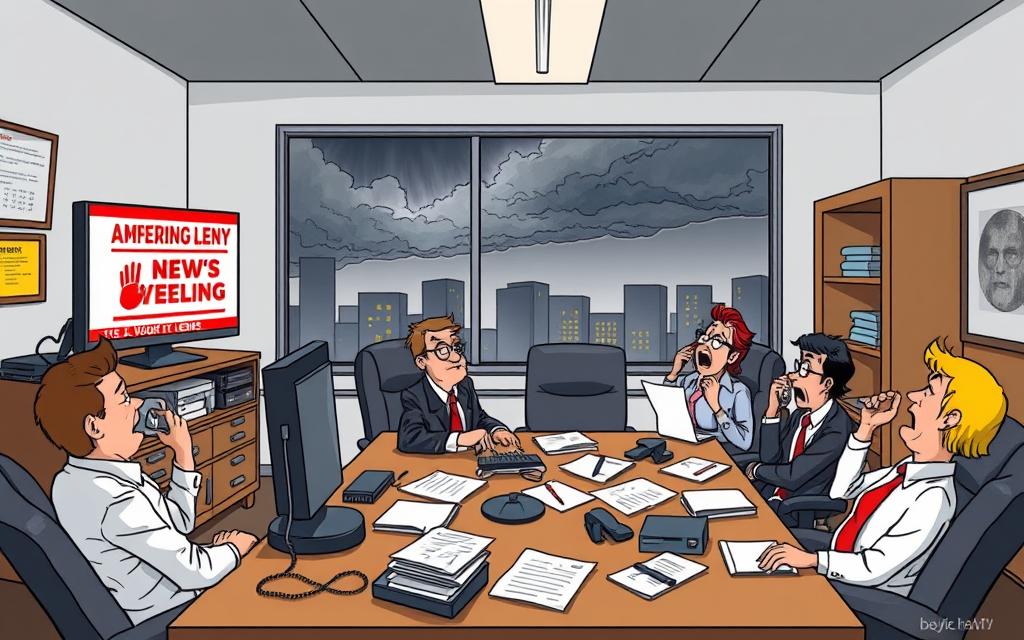PR crises can hurt businesses a lot. They can damage your brand’s image, lose customer trust, and hurt sales. This guide will show you how to deal with and bounce back from an online PR crisis. You’ll learn how to lessen the damage and take back control of your story. If you are ready for a free consultation, click here to request a time.
If your business has faced issues like data privacy problems, product recalls, or social media backlash, this guide can help. It will teach you how to figure out the damage, create the right messages, talk to those affected, keep an eye on things, and win back trust. By using online reputation management (ORM) strategies, you can come out stronger and ready for future challenges.
Key Takeaways
- Understand the potential impact of an online PR crisis on your business, including lost revenue, damaged reputation, and erosion of customer trust.
- Develop a comprehensive crisis management strategy, involving key stakeholders and communication channels.
- Craft a clear and transparent messaging strategy to address the crisis and demonstrate your commitment to resolving the issue.
- Actively monitor online conversations and sentiment to inform your response and ensure you’re controlling the narrative.
- Leverage online reputation management tools and techniques to rebuild trust and improve your brand’s perception in the long run.
What is a PR Crisis?
A PR crisis is a negative event or review that affects a business. It spreads quickly in the public eye, harming the company’s image. If companies don’t respond well, the damage can last a long time. It can hurt a brand’s trust and relationships with customers.
Examples of a PR Crisis
Examples include data privacy scandals like Facebook and Cambridge Analytica. Also, internal misconduct issues, like Uber’s sexual harassment allegations. And product failures, like Samsung’s Galaxy Note 7 battery problems. These can badly hurt a company’s online reputation and how people see it.
- Data privacy scandals (e.g., Facebook and Cambridge Analytica)
- Internal misconduct issues (e.g., Uber’s sexual harassment allegations)
- Product failures leading to safety concerns (e.g., Samsung’s Galaxy Note 7 battery problems)
It’s key to spot and tackle what is a pr crisis early. This helps stop it from getting worse. With a good plan, companies can lessen the harm. They can keep their brand’s trust and credibility with everyone involved.
If you are ready to order a recovery service, click here >>>

Potential Impacts of a PR Crisis
A PR crisis can have big effects on a business. It can lead to lost customer trust and lower sales. A mishandled crisis can hurt a company’s operations and profits.
- Damage to Brand Reputation: A PR crisis can quickly spread online. This can make people doubt the company’s trustworthiness.
- Reduced Market Share: A crisis can make customers less likely to choose the brand. This can lead to a drop in market share over time.
- Difficulty Attracting New Customers: A bad reputation can scare off new customers. They might worry about the company’s crisis management skills.
- Challenges in Recruiting and Retaining Talent: A PR crisis can also make it hard to find and keep good employees. They might not want to work for a company with a bad reputation.
Research shows that product issues can get 135 times more negative coverage than usual during a crisis. Also, data breaches and governance crises can have the worst media sentiment six months later. It’s important for businesses to manage crises well and work on rebuilding trust to avoid these problems.
| Crisis Type | Short-Term Impact | Long-Term Impact |
|---|---|---|
| Product Issues | 135x more negative coverage | Moderate |
| Data Breaches | Moderate | Most negative media sentiment 6 months later |
| Governance Crises | Moderate | Most negative media sentiment 6 months later |
| Social/Political Crises | Minor | Minor |
Understanding the effects of a PR crisis and acting early can help businesses. They can prepare for and handle these situations better. This protects their success and reputation in the long run.

Steps to Handle a PR Crisis
When a PR crisis hits, it’s vital to act fast and with purpose. First, gather a team of experts, both from within and outside your company. This team needs to know their roles and have a solid plan for handling the crisis.
Appoint a Response Team
Choose your crisis team wisely. They should have the right skills and authority to make quick, smart decisions. A recent study found that 95% of business leaders say they need to improve their crisis management skills. So, picking the right team is crucial.
Devise a Strategy and Brief Your Team
After your team is ready, create a detailed crisis plan. This plan should outline actions, messages, and how to talk to those affected. About 62% of companies have a crisis plan, but only 40% have practiced it. Make sure your team knows the plan well and can follow it smoothly.
Having a good crisis communication plan is key. 41% of businesses have communication plans in their crisis strategies. This means having messages ready for social media and the press, and knowing how to speak in a crisis. Less than half of companies have messages ready for social media and the press. Being ready can help lessen the crisis’s impact and take back control of the story.
| Statistic | Percentage |
|---|---|
| Business leaders admitting their crisis management skills need improvement | 95% |
| Companies with a crisis management plan | 62% |
| Companies that have never conducted a crisis exercise | 40% |
| Businesses with communication protocols in their crisis management strategies | 41% |
| Companies with pre-drafted messages for social media and press during a crisis | Less than 50% |

Craft Your Message
When facing a PR crisis, crafting a clear message is key. Companies should be open, honest, and take responsibility for their actions. This approach helps to build trust and shows a commitment to change.
It’s important to address the concerns of those affected and explain how you plan to fix the problem. You should also reassure everyone that you’re learning from the crisis and working to prevent it from happening again.
In some cases, it might be wise not to make a public statement. This can help avoid drawing more attention to the issue. But if a statement is needed, it’s crucial to do it right.
- Ensure transparency and honesty in your communication, even if all details cannot be shared.
- Acknowledge the concerns of affected parties and outline the steps being taken to resolve the issue.
- Reassure stakeholders that the company is committed to learning from the experience and preventing similar crises in the future.
- Avoid deflecting blame or downplaying the significance of the situation.
- Consider the timing and frequency of your communication, as the nature of the crisis dictates the appropriate response timeframe.
By focusing on transparency, honesty, and a genuine effort to solve the problem, companies can get through a PR crisis. This approach helps keep the trust of stakeholders.

“Effective crisis communication is not just about issuing statements – it’s about building trust and credibility with your stakeholders.”
Identify and Address Affected Parties
When facing a PR crisis, it’s key to quickly find and talk to those affected. This includes employees, stakeholders, business partners, customers, and the media. Each group needs a special plan to address their worries and build trust.
Employees, Stakeholders, and Business Partners
Talking to your employees, stakeholders, and business partners is very important. Give them clear, honest updates on what’s happening and what you’re doing to fix it. Show you hear their worries and are working on a solution.
This keeps everyone on the same page, cuts down on rumors, and helps them deal with the crisis together.
Customers and the Media
Talking to customers and the media needs a smart plan. Make messages that meet their needs and worries, while keeping control of the story. Use social media, press releases, and direct messages to show you’re serious about fixing the problem.
Quick and good communication with all affected can lessen the crisis’s impact. It’s a step towards rebuilding trust. By focusing on talking and tailoring your messages, you can get through the crisis stronger.
| Affected Party | Communication Objectives | Strategies |
|---|---|---|
| Employees | Provide updates, address concerns, maintain alignment | Internal memos, town hall meetings, one-on-one discussions |
| Stakeholders and Business Partners | Maintain transparency, demonstrate proactive response | Personalized emails, conference calls, face-to-face meetings |
| Customers | Acknowledge concerns, provide reassurance, maintain trust | Social media updates, customer service interactions, public statements |
| Media | Control the narrative, demonstrate accountability, provide timely information | Press releases, media interviews, press conferences |

By finding and talking to all affected, you can better handle a PR crisis. This helps in rebuilding trust and your reputation.
Monitor the Situation
When facing a public relations crisis, it’s key to keep a close eye on things. Track online talks, watch for brand and crisis keywords, and use data analytics. This helps you understand public views and act fast to protect your reputation.
Track Online Conversations
It’s vital to watch social media, review sites, and news closely during a crisis. This lets you see how people react and spot new issues. With this info, you can tweak your crisis plan to stay ahead.
Monitor Brand and PR Crisis Keywords
Watching brand and crisis keywords gives you deep insights. It shows how far and how strong the bad news is. This helps you make smart choices and act quickly.
Using data and analytics is crucial in managing a crisis. They help you make decisions based on facts, respond fast, and control the story. This protects your brand’s image.
“The key to navigating a PR crisis is staying on top of the situation. Continuous monitoring and analysis of online conversations and brand-related metrics are essential for making informed decisions and mitigating further damage.”
In today’s fast world, quick action on emerging issues is crucial. A proactive monitoring approach lets you respond well and come out stronger.
Review and Learn from the Experience
After a PR crisis is over, it’s key for companies to review their actions. This review helps find ways to improve and get ready for future crises. By learning from past mistakes, companies can improve how they talk to the public and manage their online image.
Looking back at how the crisis was handled is important. It’s about checking if the response team did well and if the company’s image was affected long-term. This deep look can show how to better communicate in emergencies, make quicker decisions, and talk to stakeholders better.
- Analyze the effectiveness of the crisis response strategy
- Evaluate the performance of the response team and communication protocols
- Assess the long-term impact on the organization’s reputation and business operations
- Identify lessons learned and areas for improvement
- Develop action plans to strengthen crisis preparedness and prevent future incidents
By reviewing and learning from the experience, companies can get better at dealing with crises. This way, they can lessen the immediate damage and build a strong reputation for the long run.
A good review after a crisis can reveal important lessons. By learning and changing, companies can come out stronger and more ready for future challenges.
What Not to Do During a pr crisis
When a PR crisis hits, there are key actions to avoid. Deflecting blame or trying to shift shows a lack of accountability. It can hurt trust. Also, a slow or fake response makes it seem like you’re hiding something.
Deflecting Blame
Trying to blame others during a crisis is a big mistake. It shows you’re not taking responsibility. Instead, own up to the problem and show how you’ll fix it.
Delayed Response
A slow or insincere response can harm your reputation. It looks like you’re not serious about fixing the issue. Businesses should respond fast, be open, and truly commit to solving the problem.
“The way a company handles a crisis can make or break its reputation. Deflecting blame and delaying the response are two of the biggest mistakes businesses can make during a PR crisis.”
To handle a PR crisis well, take responsibility and apologize genuinely. Show a clear plan to fix the problem and prevent it from happening again. Being transparent and committed can help rebuild trust and make your company stronger.
Assessing the Damage of a PR Crisis
When a PR crisis hits, the first thing to do is figure out how bad it is. You need to look at both media and non-media metrics. This helps you see how it affects your company’s reputation, what customers think, and your business’s performance.
Some key data points to check include:
- Social media engagement (likes, shares, comments, sentiment)
- Online reviews and ratings
- Search engine rankings and website traffic
- Sales figures and market share
By looking at this data closely, you can understand the crisis’s full impact. Then, you can make a plan to fix the problems and restore your brand’s trust.
It’s worth noting that 95% of business leaders say they need to improve their crisis management skills. This shows how crucial it is to have the right tools and methods to measure PR crisis damage.
| Metric | Importance | Measurement Tools |
|---|---|---|
| Social Media Engagement | Gauge customer sentiment and brand perception | Social listening tools like Brand24 and Prowly AI |
| Online Reviews and Ratings | Understand the impact on customer trust and loyalty | Review aggregators and reputation management platforms |
| Search Engine Rankings and Website Traffic | Assess the crisis’s effect on brand visibility and online presence | Google Analytics, SEO tools, and media monitoring platforms |
| Sales Figures and Market Share | Evaluate the financial impact and long-term business performance | Internal sales data, industry reports, and financial analysis |
Using the right tools and methods helps you measure a PR crisis’s impact. This way, you can create a detailed plan to lessen the damage and rebuild your brand’s reputation.
“Preparation is the key to effective crisis management. By understanding the potential impact and having the right tools in place, you can respond quickly and effectively to minimize the damage to your brand.”
Engaging Stakeholders During a Crisis
When a PR crisis hits, it’s key for businesses to talk to their important stakeholders. This includes investors, business partners, and others. They need to share clear updates on what’s happening and what they’re doing to fix it. This helps keep stakeholders confident and builds trust for the future.
The US Crisis Management Institute’s 2021 report shows a shift in crisis types. In 2020, 51% of crises were sudden, while 49% were smoldering. This highlights the need for a quick, effective crisis communication plan.
Effective stakeholder engagement during a crisis involves several key strategies:
- Timely and proactive communication: Share facts to stop false stories and explain what’s being done to solve the problem.
- Tailored engagement strategies: Different groups, like employees and customers, have unique needs. Use customized messages for each.
- Designating relationship owners: Choose specific people to talk to stakeholders. This ensures consistent messages.
- Utilizing appropriate communication channels: Pick the best ways to reach each group, like direct messages or social media.
- Developing customized messaging: Create messages that resonate with each group to build trust.
- Training internal stakeholders: Teach employees how to communicate with audiences and handle media.
- Correcting misinformation promptly: Address false information quickly to keep credibility.
By using these strategies, businesses can engage with stakeholders, stay transparent, and start rebuilding trust and reputation.
| Stakeholder Group | Communication Priorities | Preferred Channels |
|---|---|---|
| Investors | Timely updates on financial impact, actions taken, and recovery plan | Direct outreach, investor relations webinars, email alerts |
| Business Partners | Reassurance of continued operations, impact on contracts, and mitigation strategies | One-on-one meetings, video conferences, email updates |
| Employees | Transparent communication on the crisis, job security, and support available | Town hall meetings, internal emails, intranet updates |
| Customers | Acknowledgment of the issue, impact on service or products, and resolution plans | Social media, customer support channels, email newsletters |
| Regulators | Compliance updates, corrective actions, and ongoing cooperation | Direct communication, formal reporting, regulatory filings |
Shaping Public Perception
When a PR crisis hits, it’s key to take back control of the story. Companies need to share clear, honest statements about what happened and how they’re fixing it. This shows they’re open and serious about solving the problem.
Being active online is also vital. Watch what people say on social media and respond quickly to any bad comments. Using media and social platforms helps companies steer the conversation and stop false rumors. This way, they can win back trust from customers and the public.
Issue Public Statements
When a crisis strikes, it’s crucial to speak up clearly and honestly. Say sorry for any mistakes, show you care about those affected, and explain how you’re going to fix it. This shows you’re accountable and serious about making things right.
Take Control Online
In today’s world, what happens online can greatly affect a company’s image. To take back control, businesses must watch and respond to online talks about the crisis. Use social media to share updates and talk directly to customers. Working with experts in reputation management can also help shape the online story and stop false info.
By focusing on clear statements and managing their online presence, companies can change how people see them during a crisis. This is a big step towards rebuilding trust and fixing their reputation.
“In a crisis, be aware of the danger–but recognize the opportunity.” – John F. Kennedy
Rebuilding Trust After a Crisis
When a company faces a public relations crisis, the goal is to rebuild trust. This involves transparency, consistent communication, and a commitment to positive change. By addressing the crisis and preventing future ones, businesses can win back their audience’s trust and loyalty.
Admitting the crisis and taking responsibility is key. Being open and clear in communication is crucial. Customers and stakeholders need to see the company is working hard to fix the issue and prevent it from happening again.
Showing a commitment to positive change is also vital. This might mean updating policies, creating an ethical culture, and doing social responsibility work. By taking action to fix the crisis and prevent future ones, companies show they’re serious about regaining trust.
Rebuilding relationships with those affected is another important step. This includes reaching out, keeping communication open, and addressing individual concerns. Doing this helps to rebuild trust and loyalty.
The journey to regain trust after a crisis is long and hard. But it’s essential for any business to come out stronger. By focusing on transparency, accountability, and positive change, companies can work their way back to trust and credibility.
Case Studies: Successful Crisis Management
When a PR crisis hits, businesses must act fast and make smart decisions. Looking at how others have handled these situations can teach us a lot. It helps us learn how to deal with our own PR problems.
Starbucks’ response to a racial discrimination issue in 2018 is a great example. They closed over 8,000 stores for racial bias training, losing about $12 million. But this bold move showed they were serious about fixing the problem and earning back trust.
Samsung’s move with the Galaxy Note 7 battery issues is another lesson. They faced big financial and reputation losses. But their clear communication and quick recall helped them manage the crisis well. They kept customers safe and eventually won back their trust.
The scandal involving Facebook and Cambridge Analytica shows how important good crisis management is. Facebook’s efforts to fix the data privacy issue, like apologizing and changing policies, helped them regain trust. This shows how crucial it is to be open and honest during a crisis.
These examples show how key transparency, talking to stakeholders, and having a solid crisis plan are. By learning from these companies, we can improve our own crisis management. This helps protect our brand and reputation.
“Effective crisis communication plans have been shown to mitigate damage to an organization’s reputation, with 78% of cases demonstrating that consistent messaging is key to controlling the narrative during a crisis.”
The Role of Online Reputation Management
Online reputation management (ORM) is key in handling a PR crisis. It helps manage and recover your brand’s credibility. By watching your online presence, fixing bad reviews, and sharing good content, you can lessen the crisis’s impact.
ORM uses search engine optimization, content marketing, and social media. These tools help control the online story. They push down bad info and show your effort to fix problems and avoid future ones.
Being proactive in reputation management can also prevent crises. By always checking your online image and fixing issues, you build a strong reputation. This reputation can handle a crisis better.
“2024 is highlighted as a critical year for managing online reputation due to the potentially devastating consequences of a tarnished online image.”
In today’s digital world, your online image is crucial. A good ORM strategy is vital for protecting your brand. It helps regain control of your online image and ensures success in the long run.
The Importance of Proactive ORM
Proactive reputation management is key to avoiding future crises and gaining long-term loyalty. By always checking your online image, fixing bad feedback, and sharing good content, you build a strong reputation. This reputation can handle a crisis better.
- Identify and address potential threats early on
- Establish a positive online presence through content creation and social media engagement
- Respond promptly to negative reviews and customer complaints to demonstrate your commitment to customer satisfaction
- Leverage search engine optimization (SEO) to manage your online reputation and push down negative search results
By being proactive in ORM, you gain trust with your audience. You attract new clients and make sure your brand is ready for any PR challenges.
Proactive Strategies to Prevent PR Crises
Managing and recovering from a PR crisis is key, but preventing them is even better. To do this, businesses should create a detailed crisis management plan. They should also look for potential risks and build a culture of transparency and accountability.
Companies should keep an eye on their online and update their crisis communication plans. They should also train their employees to spot and solve problems early. This way, companies can stay strong, avoid PR crises, and be ready to handle them if they happen.
Businesses with a good crisis plan lose less money and see their stock value drop less during a crisis. For example, Chipotle kept its reputation after an E Coli outbreak thanks to a strong food safety plan and quick apology.
The importance of crisis planning and preparedness is huge. Without a plan, companies can lose trust and public favor. Getting experts for crisis management is a smart move to handle crises well.
- Make a detailed crisis management plan with communication and response strategies.
- Keep an eye on online conversations and brand mentions to catch issues early.
- Build a culture of openness and responsibility in your company, letting employees speak up and help prevent crises.
- Train and practice for crises to make sure your team is ready.
- Use data and analytics to improve your crisis readiness and decision-making.
| Proactive Measure | Benefits |
|---|---|
| Comprehensive crisis management plan | Less financial loss, better public image |
| Continuous online reputation monitoring | Finds issues early, responds faster |
| Fostering a culture of transparency | Builds trust, lets employees solve problems |
| Regular crisis simulation training | Improves team readiness and decision-making |
| Data-driven crisis preparedness | Better decision-making, more effective crisis response |
By using these proactive strategies to prevent PR crises, businesses can become more resilient. They can reduce the chance of damaging incidents and be ready for tough situations.
Conclusion
Handling an online PR crisis needs a mix of fast action, clear communication, and a focus on rebuilding trust. A skilled team, a solid messaging plan, and talking to affected people are key. Using online reputation management techniques helps a lot. This way, businesses can reduce damage and come out stronger.
Being ready for a PR crisis is crucial for any business. It’s not just about protecting your reputation now. It’s also about building trust and credibility for the future. This is vital in today’s digital world.
A proactive approach to managing your reputation is vital. It helps businesses of all sizes stay strong and keep customer trust. By learning from online PR crises, you can make your brand more resilient. This helps you face the digital world’s changing challenges.
Effective crisis management protects your business in the short term. It also boosts your brand’s credibility and trustworthiness. Use what you’ve learned, improve your strategies, and come out stronger. Be ready to face and overcome future challenges.

